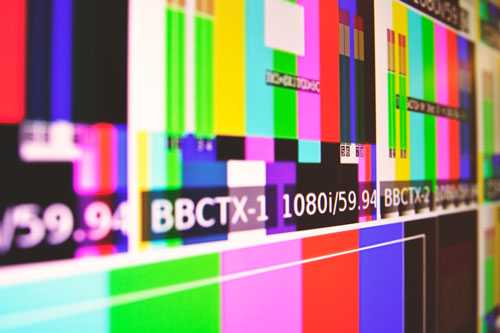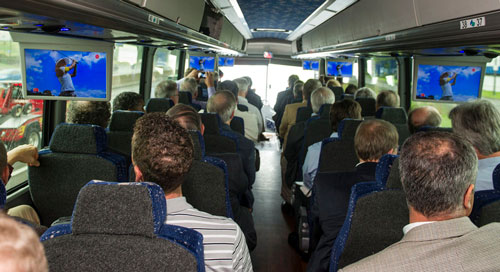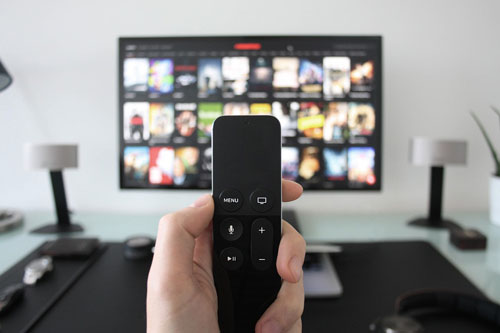Our Next Annoying National Upgrade
Nine years ago, the federal government painfully pushed the public into the arms of digital TV. Soon enough, we could be making that upgrade all over again.
Today's GIF features some fun-to-watch color bars, minus the color.
Sponsored By … You?
If you find weird or unusual topics like this super-fascinating, the best way to tell us is to give us a nod on Ko-Fi. It helps ensure that we can keep this machine moving, support outside writers, and bring on the tools to support our writing. (Also it’s heartening when someone chips in.)
1941
The year that the National Television System Committee, a group formed a year prior at the behest of the Federal Communications Commission, created the first official standards for television, then in its black and white form. (You can read about those standards here.) A later iteration of the organization, formed in 1950, also put together at the behest of the FCC, helped come up with standards for color television. The Advanced Television Systems Committee, or ATSC, was formed in 1983 in an effort to decide upon future improvements to the television system. The group, which is still active today, gave us the current digital television standards used in the U.S. and many other countries.

(Tim Mossholder/Unsplash)
Why we’re seeing a push for an improved television standard despite the current one doing the job
In the last piece I wrote about digital television, I noted that there were pockets of people who felt that the replacement ultimately wasn’t as good an option as the system that we lost—i.e., the staticky one that worked well with nearly every television set produced over a 60-year period.
Of course, those cries of disappointment were in vain. By that point, the broadcast industry and the U.S. government (along with their international counterparts) had put so much time, money, and energy into creating a more modern iteration of over-the-air television that there was no turning back even if they wanted to.
At this point, ATSC 3.0 isn’t nearly at the no-turning-back point. But it is knee-deep in its experimental stages, something that the committee has been working on since at least 2011, with a clear desire to build with an eye toward the next generation of televisions. ATSC 1.0, or HDTV, was built a quarter-century ago; they’re future-proofing for the next quarter-century, which is why they appear to have blown past ATSC 2.0.
Fred Baumgartner, the man who is currently heading up the transition efforts for the local-TV conglomerate Sinclair Broadcasting, wrote a detailed piece for TV Technology last year (while he was working for a different company, Nautel) that explains the key issue the platform is trying to solve: The internet protocol, or IP, distribution capabilities used by over-the-top (OTT) services like Netflix or Hulu take up a lot of the internet’s bandwidth, bandwidth that would be more effectively accessed through wireless spectrum, where there’s more bandwidth room. From his piece:
While the bulk of all Internet traffic is video by a wide margin, it is still a very small amount of the total video consumed. Video-on-demand from OTT sources like Netflix, Youtube and Hulu, as well as the broadcast networks, is being consumed on devices that can be used nearly anywhere—including a lot of places [over-the-air] TV doesn’t reach. Internet access and capacity is growing, consuming more RF “wireless” spectrum and reaching farther into the corners of the world. This is the gap ATSC 3.0 fills.
Only a sliver of TV viewing is delivered via IP and the IP networks are a long way from having the capacity to deliver all of the TV consumers watch with the quality they expect. Right now, IPTV is a bit of a miracle; it’s a bundle of buffers, sparingly supported multicast protocols, switches, edge servers, and best effort adaptive streaming techniques. It is well understood that watching an Internet video may or may not be a good experience. Reflect on how the far rarer “rain fades” on direct-to-home satellite are considered by many viewers as an “insufferable” impairment.
Baumgartner goes on to explain how an effective solution to the broadcast challenge is to combine data from the internet and data from over-the-air broadcasts in a way that it takes advantage of the benefits of both without outweighing one or the other.
This is probably the biggest feature of ATSC 3.0, but it’s one of many. Internally, the committee describes the initiative as “a suite of voluntary technical standards and recommended practices,” one that represents far more sophistication than previous television standards.
Or another way to put it: If done right, it’ll make you never miss your crummy CRT ever again.

LG shows off ATSC 3.0 capabilities on a bus. (via LG's Flickr page)
Five of the many features of the ATSC 3.0 standard
- Super-duper high resolution. Current ATSC standards, which support 1080i resolutions of 1920 by 1080 pixels, haven’t kept up with the resolutions of current TV sets, which now support 4k resolution, also called ultra-high-definition television (UHDTV). “Note that it is the intention for the ATSC 3.0 System to support delivery to fixed devices of content with video resolutions up to Ultra High Definition 3840 by 2160 at 60 fps, or such higher frame rates and/or resolutions as may be determined to be desirable and practical,” the organization explains in its overview of the standard. The standard will also include greatly improved audio and will support high-end video and audio codecs that make the most of the over-the-air bandwidth.
- Mobile television capabilities. One of the weak points of the current digital television standards used in most parts of the world is that they’re not designed to be used in mobile contexts—which makes sense, as the standards were largely built before mobile phones had taken over the world. ATSC 3.0 attempts to fill this gap, however, by allowing mobile playback on phones at 1080i resolutions.
- Built-in channel guides. Like the annoying cable boxes of the present, the ATSC system includes a standard for service messaging which is intended to make it easier for people to find something to watch or even load up video on demand functionality. Hopefully this means you need a little less hardware in the long run.
- Watermarking. The system will also be a boon for copyright-holders, as it will include built-in standards for audio and video watermarking, which could help with the pesky piracy problems common with television shows.
- “Service usage reporting,” a.k.a. tracking. Famously, Nielsen has always had a hard time trying to figure out who’s watching what, leading to issues where shows that were widely appreciated by audiences got low ratings because Nielsen’s samples were off. ATSC 3.0 includes tracking capabilities built right in, which advertisers are going to love, but also has benefits for consumers—if the system knows you live in a certain area during a time of emergency, it might be able to potentially warn you. Of course, this cuts both ways, because people already hate being tracked on the internet.
3-2
The FCC’s vote to allow ATSC 3.0 on a voluntary basis last month. The vote, like many that have happened under the commission’s watch in the Ajit Pai era, highlights the strongly partisan split facing telecom issues these days. The measure got a fairly muted response outside the realm of the telecom sphere, with some major fans (the National Association of Broadcasters, of course) and fairly loud critics (particularly the American Cable Association, a group that represents small or independent cable television operators). The vote nonetheless reflects that this was not an easy approval by any means.

So what will ATSC 3.0 mean for your television experience?
Well, at the moment, not much. It’s voluntary for now—you’re not going to be required to do anything to upgrade your TV to view broadcast signals, like you did in 2009. (Your phone might need an upgrade someday, though it might be tough with the lack of ATSC support on smartphones at the moment.)
If you want 4K signals over broadcast, this is your path, but ultimately not a lot of people are clamoring for that right this second. For now, you’re not going to find many options on the market that support the new technology, let alone stations that can make the technology work. (Head to South Korea if you don’t want to wait.)
However, it could become a much bigger deal down the road, for one reason: ATSC 3.0 is not backwards compatible with your current digital television.
The hardest part of the 2009 digital television switchover for consumers, if you’ll remember, was the purchase of upgrade equipment that was cheaply made and pushed along by vouchers handed out by the federal government—something mandated by a 2005 law.
Notably, the current FCC rulemaking makes no attempt to make allocations for such upgrade equipment, as it’s not considered necessary for now.
Of course, all of this has the potential to leave out a whole lot of have-nots if it’s not eventually remedied. FCC Commissioner Jessica Rosenworcel, who has emerged as the highest-profile critic of Ajit Pai, suggested in her comments against approving the new broadcast technology that the transition period between ATSC 1.0 and ATSC 3.0 will create a period in which “consumers could find their bills going up because they will be stuck paying for two signals—even though their current television set can only receive one.”
And after that? “It’s a tax on every household with a television,” she says.
On the other hand, it’s worth pointing out that the pain isn’t expected to be as dramatic as it was in 2009. In his 2016 article discussing the technical elements of a switchover, Sinclair’s Fred Baumgartner makes the case that a forced upgrade, if it ever happens, likely won’t be as dramatic because we already did the hard part by upgrading to digital in the first place.
“In this case, the digital transition is history, we have flat screens and devices … and all that is missing is a means to connect broadcast TV to them,” he writes, adding that dongles that hook up to HDMI ports will likely be the way many people upgrade their sets.
That said, dongles and set-top boxes won’t be the only upgrade path. At last year’s National Association of Broadcasters convention, the TV-maker LG showed off a unique kind of antenna that redistributes broadcast signals through a wireless router, which could help maximize the signal through devices that don’t already have an existing way to parse an ATSC signal. The approach would make it so that smartphones, tablets, and television sets would be able to use the antenna without dedicated internals, removing a major pain point of past antenna technology.
There is some good here; there is some bad. But it’s possible that in just a few years, cutting the cord might mean something different than it does now.
Whatever the strengths or weaknesses of ATSC 3.0, I think it’s important that we don’t lose sight of the fact that from a technological standpoint, this is an interesting time.
Currently, there are experimental television stations running the new signals, including in Cleveland, where an experimental license from the FCC has allowed industry officials to work out the kinks of the technology. Currently, the National Association of Broadcasters and the Consumer Technology Association plan to staff a test station in the city in coming years to ensure everything’s working swimmingly. (The first to broadcast ATSC 3.0, however, was North Carolina's WRAL, shown above.)
And some companies, like the aforementioned Sinclair Broadcasting, are jumping to go.
“We are ‘off the plateau’ and ready to climb the next mountain along with our broadcast brethren, manufacturers, programmers and new business partners, looking down on wondrous new opportunities,” said the company’s executive chairman, David Smith. “There should only be upside for all concerned—including most importantly, the Public!”
There’s a reason Sinclair is more excited than most about this upgrade. It’s the company thinking in the boldest terms about what it could mean for television.
See, Sinclair, along with Nexstar Media Group and a few other companies, has discussed the idea of using the new standard for datacasting, which would allow for downstream data delivery through broadcast signals.
To put this in layman’s terms, ATSC 3.0 could enable companies to speed up the download of heavily used content—say, Netflix—by letting users stream it from servers at their local TV station, rather than over the internet.
And since the ATSC 3.0 protocol is designed to allow internet connections to communicate with broadcast signals, it’s not beyond the realm of possibility that we might someday see the possibility that Hulu or Netflix would be available as an over-the-air broadcast channel, weird as that sounds.
This approach, as laid out, could open up a can of worms, however, effectively creating “fast lanes” for companies that can afford dedicated pipes offered by broadcasters, so it will be interesting to see where Sinclair and technology take that basic idea.
But in this context, Sinclair’s high-profile attempt to purchase Tribune and get the FCC rules changed in its favor takes on a completely different tenor. Suddenly, buying Tribune seems less about owning the stations and more about potentially reshaping the way people use the internet.
I don’t mean this to sound conspiratorial or even over-the-top. Rather, I just want to point out that this is a dramatic reframing of what we’ve come to expect from our TV sets. In many ways, this is as big a deal as net neutrality, because the shift is so dramatic—in many ways for good, in other ways that we should discuss before we buy in.
Let’s get the static out of the way now.
:format(jpeg)/2017/12/tedium120517.gif)
/2017/12/tedium120517.gif)


/uploads/ernie_crop.jpg)